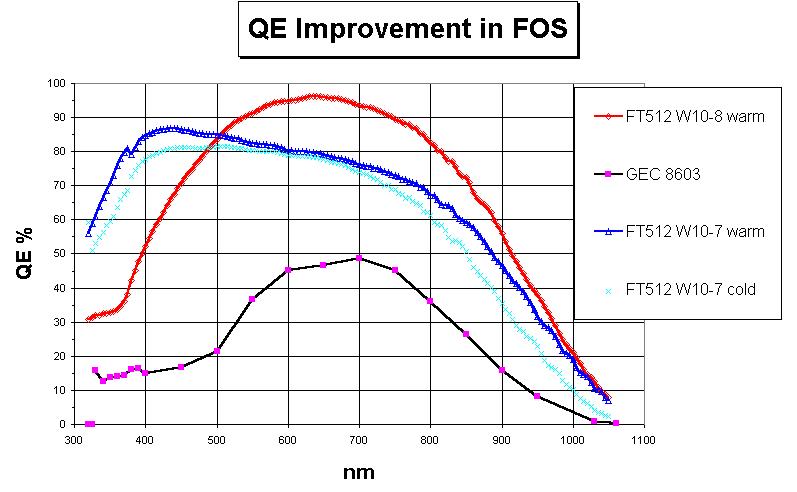Chip name
FOS1
Year of manufacture: 1997
Serial number: FT512 w11-8
First light on La Palma: Feb. 1998
Description: Thinned backside illuminated with passivated platinum surface.
Operational Characteristics
Measurements made on
|
Speed
|
Standard
|
Quick
|
|
Bias(ADU)
|
1147
|
1120
|
|
Gain(e/ADU)
|
0.79
|
1.27
|
|
Noise(e)
|
8.6
|
11.4
|
|
Linear to(ADU)
|
60000
|
37000
|
|
Readout time(s)
|
|
20
|
Binning - NB when binning is selected the readout speed is TURBO
regardless of the readout speed selected.
Vertical CTE
0.999994
Horizontal CTE
0.999996
Physical Characteristics
Pixel Scale
? arcsecs/pixel
X Pixel size
15 microns
Y Pixel size
15 microns
X size in pixels of digitised area
528
Y size in pixels of digitised area
1124
X size of useful imaging area
512
Y size of useful imaging area
1024
X start of useful imaging area
1
Ystart of useful imaging area
1
LN2 capacity of cryostat
2.5 litres
Operational Parameters
Flooding type
Passivated Platinum Process - The high QE of this device in the blue
is due to the passivated platinum surface treatment of the CCD. This treatment
is particularly prone to surface contamination of the chip such as will
occur if the LN2 supply runs out with the chip still cold. If the camera
is to be warmed up it is essential therefore that the CCD temperature servo
be set to an elevated temperature prior to LN2 exhaustion. If the surface
does become contaminated, it will show itself as a loss of blue sensitivity
and a very mottled flat field response. The activity of the Platinum treatment
can be restored by the following steps :
1) Warm up the camera.
2) Pump for one hour.
3) Backfill the camera through the vacuum pump. This will bathe the
chip in dry air since the pump should contain a moisture trap.
4) Leave for one hour, then re-pump for at least a further hour.
5) Refill with LN2 immediately after disconnecting the vacuum pump.
Controller Hardware Modifications
CDS Card gain reduced, R5 changed to 6K7
Operating temperature
173K
Preferred amplifier
B giving 8.6e noise.( A is the backup giving 8.9 e noise,, C &
D are unusable )
Network name
CCD1
Anti blooming available
no
Measured Characteristics
Quantum Efficiency - Sky blue line FT512 W10-7
 Dark current 1 electron/pixel/hour @ -107 Degrees C
after 24 hours in the dark and after being switched on for 16 hours.
Dark current 1 electron/pixel/hour @ -107 Degrees C
after 24 hours in the dark and after being switched on for 16 hours.
Point spread function -
The CCD suffers from a poor PSF
particularly at the blue end of the spectrum. Photoelectrons diffuse sideways
a considerable distance resulting in effective pixel sizes similar to the
old GEC chip used in FOS. The FWHM is approximately 1.8 pixels @ 820nm,
2.5 pixels @ 440nm.
Full well bloom limit 50000 e
Chip flatness Approximately +/- 1 micron
Cosmetics - No bad columns, very clean. Thinning defect
rounds off the image area near amplifier D, not a serious problem.
Some vertical streaks visible in flats near amplifier A. Slight rise
in bias in first few columns.
Cosmic Rays 600 events per hour

